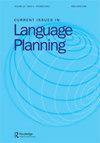通过社区挽救新加坡的普通话教育
IF 1.8
1区 文学
Q2 EDUCATION & EDUCATIONAL RESEARCH
引用次数: 0
摘要
摘要新加坡是一个多民族国家,华人占多数。自1965年独立以来,它采取了“懂英语”的双语政策,以实现经济、社会和政治目标。在过去的二十年里,主要来自英语家庭的华裔小一学生的比例迅速增加。这使得政府将普通话的教学推向了一个新的方向。1979年后,普通话才成为一种较少教授的语言,这导致了小学生家庭语言的转变。政府认识到这一社会语言学的变化,调整了课程,并强调社区学习的互补作用。人们需要考虑到这个多种族国家社会语言学特征的变化,才能理解如何管理较少教授的语言——普通话的基本原理。本文章由计算机程序翻译,如有差异,请以英文原文为准。
Salvaging Mandarin education in Singapore through community
ABSTRACT Singapore is a multiracial nation with a majority ethnic Chinese population. Since its independence in 1965, it has adopted an ‘English-knowing’ bilingual policy to achieve economic, social, and political objectives. For the past two decades, there has been a rapid increase in the percentage of ethnic Chinese Primary One students coming from primarily English-speaking families. This has caused the government to move the teaching and learning of Mandarin in a new direction. Mandarin has only become a less-taught language after 1979, causing a shift in home language for the primary school students. Acknowledging this sociolinguistic change, the government adjusts the curriculum and places emphasis on the complementary role of community-based learning. One needs to take into consideration the changes in sociolinguistic profile of this multiracial nation to appreciate the rationale of how the less-taught language – Mandarin has been managed.
求助全文
通过发布文献求助,成功后即可免费获取论文全文。
去求助
来源期刊

Current Issues in Language Planning
Multiple-
CiteScore
4.80
自引率
16.70%
发文量
26
期刊介绍:
The journal Current Issues in Language Planning provides major summative and thematic review studies spanning and focusing the disparate language policy and language planning literature related to: 1) polities and language planning and 2) issues in language planning. The journal publishes four issues per year, two on each subject area. The polity issues describe language policy and planning in various countries/regions/areas around the world, while the issues numbers are thematically based. The Current Issues in Language Planning does not normally accept individual studies falling outside this polity and thematic approach. Polity studies and thematic issues" papers in this journal may be self-nominated or invited contributions from acknowledged experts in the field.
 求助内容:
求助内容: 应助结果提醒方式:
应助结果提醒方式:


